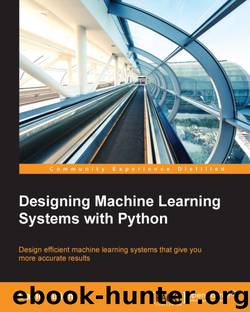Designing Machine Learning Systems with Python by 2016

Author:2016
Language: eng
Format: epub, mobi
Publisher: Packt Publishing
The ordered list approach
As we add literals to a conjunctive rule, we aim to increase the homogeneity of each subsequent set of instances covered by the rule. This is similar to constructing a path in the hypothesis space as we did for our logical trees in the last section. A key difference with the rule approach is that we are only interested in the purity of one of the children, the one where the added literal is true. With tree-based models, we use the weighted average of both children to find the purity of both branches of a binary split. Here, we are still interested in calculating the purity of subsequent rules; however, we only follow one side of each split. We can still use the same methods for finding purity, but we no longer need to average over all children. As opposed to the divide and conquer strategy of decision trees, rule-based learning is often described as separate and conquer.
Let's briefly consider an example using our conifer categorization problem from the previous section.
Download
Designing Machine Learning Systems with Python by 2016.mobi
This site does not store any files on its server. We only index and link to content provided by other sites. Please contact the content providers to delete copyright contents if any and email us, we'll remove relevant links or contents immediately.
Algorithms of the Intelligent Web by Haralambos Marmanis;Dmitry Babenko(9858)
Test-Driven Development with Java by Alan Mellor(7663)
Data Augmentation with Python by Duc Haba(7546)
Principles of Data Fabric by Sonia Mezzetta(7321)
Learn Blender Simulations the Right Way by Stephen Pearson(7238)
Microservices with Spring Boot 3 and Spring Cloud by Magnus Larsson(7071)
RPA Solution Architect's Handbook by Sachin Sahgal(6462)
Jquery UI in Action : Master the concepts Of Jquery UI: A Step By Step Approach by ANMOL GOYAL(6455)
The Infinite Retina by Robert Scoble Irena Cronin(6173)
Hadoop in Practice by Alex Holmes(6141)
Big Data Analysis with Python by Ivan Marin(5886)
Life 3.0: Being Human in the Age of Artificial Intelligence by Tegmark Max(5474)
Pretrain Vision and Large Language Models in Python by Emily Webber(4844)
Infrastructure as Code for Beginners by Russ McKendrick(4625)
WordPress Plugin Development Cookbook by Yannick Lefebvre(4344)
Functional Programming in JavaScript by Mantyla Dan(4216)
The Age of Surveillance Capitalism by Shoshana Zuboff(4210)
Embracing Microservices Design by Ovais Mehboob Ahmed Khan Nabil Siddiqui and Timothy Oleson(4114)
Applied Machine Learning for Healthcare and Life Sciences Using AWS by Ujjwal Ratan(4094)
